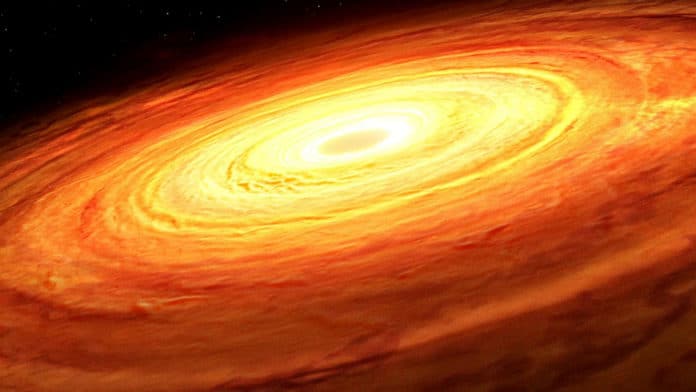When resting and not swallowing surrounding stars or gas, the supermassive black holes emit very little light. Astronomers can detect this light by analyzing its gravitational influences on stars and gas.
Supermassive black holes in the early universe used to proliferate. They used to feed or accrete materials at intensive rates actively. The radiation emitted from these black holes sometimes outshines the entire galaxy in which they reside.
A new study by the University of Illinois at Urbana-Champaign shed light on the relation between the feeding pattern of the black hole and its size. Scientists found that the flickering in the brightness observed in actively feeding supermassive black holes is related to their mass.
The light observed from the dormant supermassive black hole is inconstant. Due to this variability, the observed light displays ubiquitous flickering. This flickering can last for hours/days,/decades.
Many studies have tried to explore the relation between this flickering and the mass of a supermassive black hole, but the outcomes were inconclusive and controversial.
For this study, scientists gathered and compiled a large set of data on actively feeding SMBHs. The aim was to study the variability pattern of flickering. For this, they determined a characteristic timescale, over which the pattern changes, that tightly correlates with the mass of the SMBH.
Later, by comparing the results with accreting white dwarfs, the remnants of stars like our sun, they found that the same timescale-mass relation holds, even though white dwarfs are millions to billions of times less massive than SMBHs.
Yue Shen from the University of Illinois Urbana-Champaign astronomy said, “These results suggest that the processes driving the flickering during accretion are universal, whether the central object is a supermassive black hole or a much more lightweight white dwarf.”
Yan-Fei Jiang, a researcher at the Flatiron Institute and study co-author, said, “The firm establishment of a connection between the observed light flicker and fundamental properties of the accretor will certainly help us better understand accretion processes.”
University of Illinois Urbana-Champaign astronomy graduate student Colin Burke said, “Now that there is a correlation between the flickering pattern and the mass of the central accreting object, we can use it to predict what the flickering signal from an Intermediate black hole looks like.”
This study is a collaboration with astronomy and physics professor Charles Gammie and astronomy postdoctoral researcher Qian Yang, the Illinois Center for Advanced Study of the Universe, and researchers at the University of California, Santa Barbara; the University of St. Andrews, U.K.; the Flatiron Institute; the University of Southampton, U.K.; the United States Naval Academy; and the University of Durham, U.K.
Journal Reference:
- Colin J. Burke et al. A characteristic optical variability time scale in astrophysical accretion disks. DOI: 10.1126/science.abg9933
